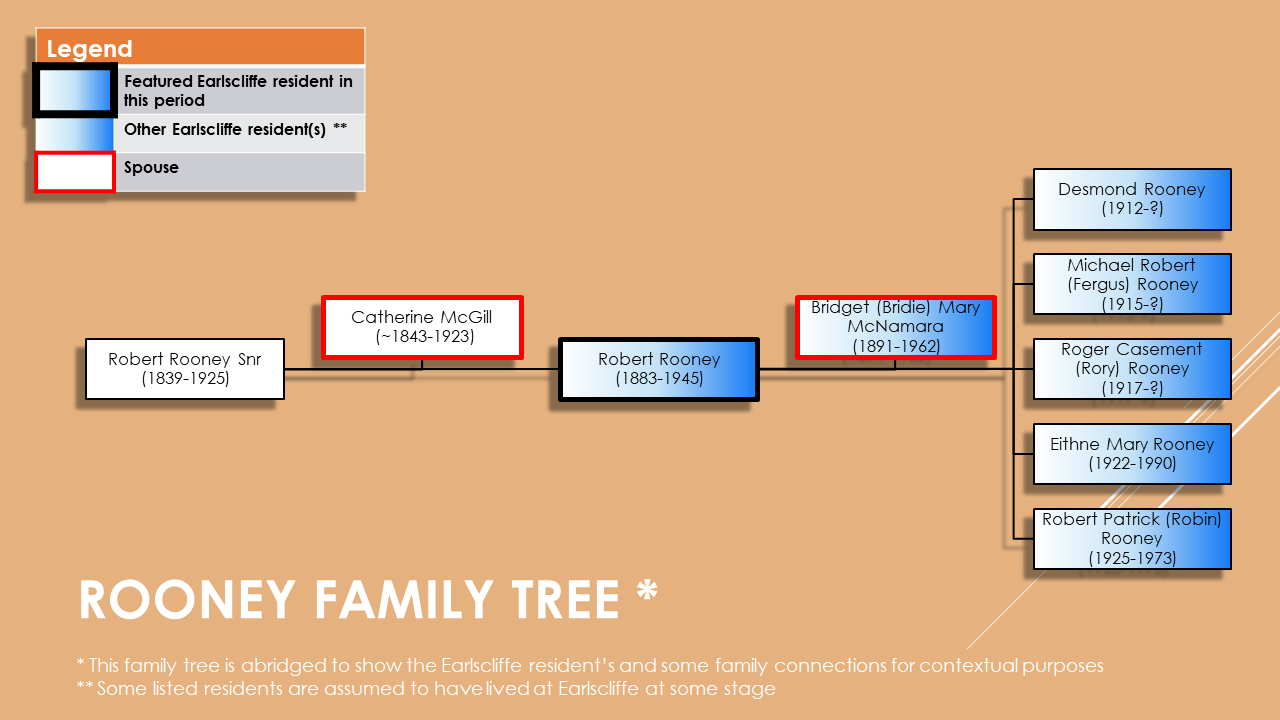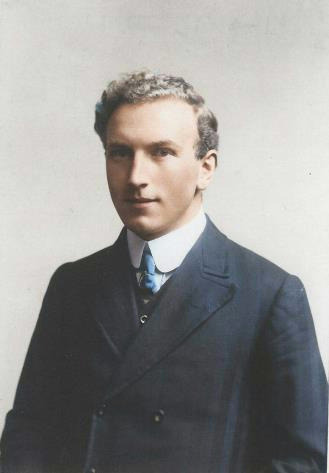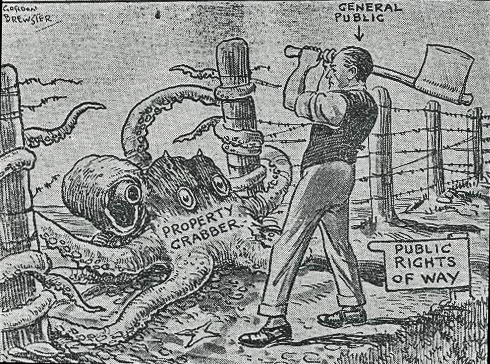History of the House / 1924 to 1927 - Robert Rooney
Previous / Next: 1922 to 1924 - CT Ovenden / 1927 to 1930 - Dr Ella Webb
See also: Dispute with Dane's Hollow
Earlscliffe Residents 1924 to 1927
In 1924, not long after he purchased Earlscliffe, the Very Rev. Charles Thomas Ovenden, the Dean of St. Patrick's Cathedral in Dublin, died, with his wife dying four weeks later.
The deeds of the house had been made jointly with one of his daughters, Florence. However, we don't believe that she lived in the house. Instead, it was rented out to Robert Rooney for a number of years. [4]
Robert Rooney
Family history

Robert Rooney was born on the 15th July 1883 in Cork. His father, also called Robert, was in the Royal Irish Constabulary (RIC), but had been forced to retire at the age of 40 due to an eye injury.

Young Robert joined the Civil Service in Cork and passed the civil services exams and by 1904 he had been appointed to the Irish Land Commission in Dublin.
He had become interested in politics and Irish nationalism, as shown in the 1911 census when he gave the Irish version of his name (Riobard UaRuadhnaigh). He was also an active member of the Gaelic League and would later become a Sinn Féin councillor.
Robert got engaged to Bridget (Bridie) Mary McNamara and they were married at the Cathedral in Ennis on the 14th June 1911. Apparently at the wedding Bridie’s new father-in-law told a story about being in the RIC, which didn't go down well with the nationalist McNamara family! [1]
The couple moved to a house initially in Clontarf before moving to Glasnevin. Robert, Bridie and their children frequently visited Howth in the summer months and Robert always wanted to live there.
Bridie McNamara
Bridie's family were very involved with the republican movement in County Clare. Her brother, Bill McNamara had joined the Irish Volunteers in 1913 and was part of the 1917 Mountjoy hunger strike when the prisoners were force fed, which led to the death of Thomas Ashe.
Bill was arrested and imprisoned several times and was a member of the Clare Brigade Flying Column.
Bridie's sister, Ettie McNamara, married Patrick Brennan in 1918. Paddy Brennan was one of the 3 Brennan brothers from Meelick in County Clare who were actively involved in the War of Independence. Michael Brennan became Major General Brennan and Chief of Staff of the Irish Defence Forces from 1931-1940.
The First World War
Britain became involved in the First World War in August 1914. Generally there was a feeling it would all be over by Christmas. In June 1915 the War Office called on civil servants of military age to enlist and this included in Ireland. In England 54% of civil servants volunteered and in Scotland the figure was 62% where in Ireland only 27% volunteered.
Sir Matthew Nathan, the recently appointed Under-Secretary for Ireland became deeply suspicious of the loyalty of the Irish civil servants. He reported that there were
...a good number of the lower officials in this undesirable organisation Sinn Féin... and we shall have to put a strong check on their increased activity.
The government also asked for secret police reports about those they suspected of being involved in the Irish Republican movement. [2]
Easter Uprising 1916
On the 4th May 1916, during the Easter Uprising, Robert Rooney was arrested at the Irish Land Commission offices with two of his colleagues, Hugh Hehir, and Patrick Sheehan, on suspicion of having participated in the Uprising.
Robert was questioned and imprisoned at Dublin Castle for 4 days.
The police searched Robert's home and found a bundle of Sinn Féin newspapers along with some newspaper articles Robert had cut out and stuck to a piece of cardboard. One article showed maps of the Battle of Verdun which was continuing in France. A second related to the number of German submarines lost, and another article (heavily annotated by Robert) discusses the German/British imports of 1913.
Hugh Hehir had been a member of the Irish Volunteers and had previously been involved with the Howth gun-running in July 1914. He had been down in Ennis, Co. Clare at the time of the Uprising and had been arrested on his return to Dublin. [3]
Patrick Sheehan was an active Irish Volunteer and was arrested at his home in the immediate aftermath of the Rising by the military. They found ammunition and a uniform in his house and, even though he had not participated in the Uprising, he was sent to Knutsford prison in England.
Rooney was eventually released in May 1916 and returned to to work
at the Irish Land Commission. According to Dr. Martin Maguire, senior lecturer in History at the Department of Humanities, Dundalk Institute of Technology, Ireland, and expert in the history
of the Irish civil service, the two men were
...cheered as returning heroes, and were once again put in receipt of government pay.
Dr. Maguire believes it is possible that Robert had been the victim of a malicious informer. [2]
In July 1916, questions were asked in the House of Commons about the arrests and subsequent release of Rooney and he was called a
...well-known Sinn Féin organiser.
As a result of this, Rooney was again suspended from his work at the Irish Land Commission and was officially dismissed on the 10th Oct 1916.
Out of work
Rooney was now out of work with a wife and two children to support.
With no income, Rooney and his family moved to Gracepark Avenue in Drumcondra in early 1917. Their third son arrived in April 1917 and was named Roger Casement in tribute to the Irish patriot.
Over the coming period, the Rooney house was raided several times and in November 1920,
Robert was imprisoned in Mountjoy for a month for offences under the Restoration of Order in Ireland Regulations 1920
.
In 1920 Robert became a Sinn Féin councillor for the North Dublin Ward (covering Clontarf and Drumcondra). However, without his Civil Service job, Rooney struggled to get work.
At about this time, 1920, the Rooney's moved to Howth where they rented a tiny cottage at 4 Balglass Cottages.
Eventually, Robert found employment working for a wine merchant and Bridie started work as a travelling saleswoman selling blouses.
End of British rule and the creation of the Free State
In the War of Independence, a ceasefire began on 11 July 1921 and the post-ceasefire talks led to the signing of the Anglo-Irish Treaty on 6 December 1921. This ended British rule in most of Ireland and, after a ten-month transitional period overseen by a provisional government, the Irish Free State was created in 1922.
During this period, on the 16th May 1922, Robert received a letter to say that he was being reinstated in the Irish Land Commission five years after his dismissal.
With his civil service job back, the family's circumstances improved considerably and soon they rented a small cottage called Glenvale in Windgate Rise on the Hill of Howth.
Move into Earlscliffe
In 1924, after the death of the Very Rev. Charles Thomas Ovenden and his wife, Robert and Bridie Rooney and family rented Earlscliffe where they would stay for a number of years.
From all accounts, Bridie particularly liked gracious living, so Earlscliffe at that time must have suited them.
The Rooneys employed a house keeper, Mrs Lynch, to look after the house whilst they both went off to work in Dublin. They would catch the tram from the Baily Post Office which would take them to either Howth or Sutton railway stations where they would then catch a train to Dublin.
In 1925, Bridie became pregnant. Robert Patrick (known as Robin) was born on the 30th October 1925 at Earlscliffe and Bridie employed a nurse to look after him so she could continue working.

Dispute with the neighbours
Whilst living in Earlscliffe, Robert had a favourite walk along the
Howth cliffs which he often took. In May 1926 a new neighbour, Mr McRory
(or MacRory), erected a barbed wire
fence with seven rows of barbed wire
which prevented
Robert from taking this walk and stopping him having access to Glenaveena Bay
(a beach next to the Lion's Head and below Dane's Hollow).
Outraged, Robert decided to take action and, accompanied by one of his sons, set about cutting the barbed wire. He was spotted by the gardener at Dane's Hollow who called the police and Robert and his son were arrested.
They were released on bail (at a cost of £5 each) and the trial date was set for the 16th June at Howth Sessions.
The court case dragged on for years but eventually Robert won.
Robert Rooney's own written account of the events can be found here:
Moving on
Around 1926/7, the Rooney's moved out of Earlscliffe to allow the late Rev Ovenden's other daughter, Dr. Ella Webb, to move in.
After Earlscliffe, the Rooney family moved to Glenomera in the Burrow Road on the Howth/Sutton border before moving to another beautiful house, Howth Lodge, beside Claremont Strand.
Bridie hoped her children would make successful marriages and needed a grand house to entertain.
By the time Robert retired in 1944 they had little in savings and a small pension to live on so they decided to move to Galway to live with their son Desmond.
Robert passed away the following year on May 10th 1945 and Bridie spent her remaining years living with her son, Desmond, and later with her daughter Eithne in England.
Bridie died on the 29th June 1962. [1]
Further information
•
List of Earlscliffe Residents
References
- [1] This information was kindly provided by Miriam Geraghty, Robert Rooney's Granddaughter, as communicated to David Foley in October 2021.
- [2] As discussed in "The Civil Service and the Revolution in Ireland 1912-38: 'Shaking the Blood-stained Hand of Mr Collins'" by Martin Maguire ISBN-10: 0719081947
- [3] As discussed in a statement by Hehir in BMH.WS0683.pdf (militaryarchives.ie)
- [4] As seen in the "Dublin Directory of Nobility, Gentry, Merchants and Traders" 1926, page 2080. The Dublin Directory of Nobility, Gentry, Merchants and Traders of 1925 and of 1926, states that Mrs. Kennedy owned Earlscliffe at this time. This is Florence Irene Harriet Kennedy, the Ovenden's youngest daughter. As we do know that the Rooney's were in the property in this period, Florence must have been renting the property out to the Rooney's.
This page was last updated on 28-Jul-2023 .
